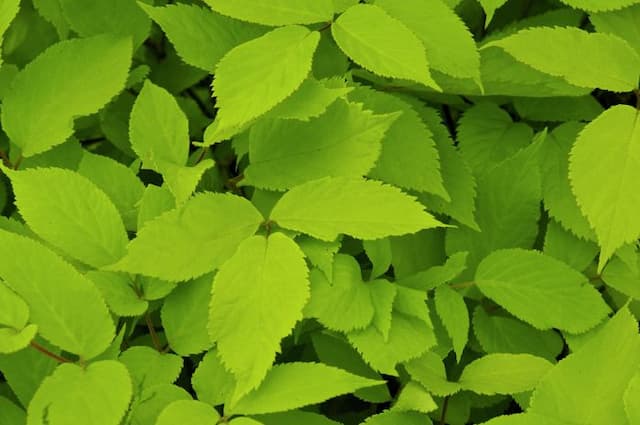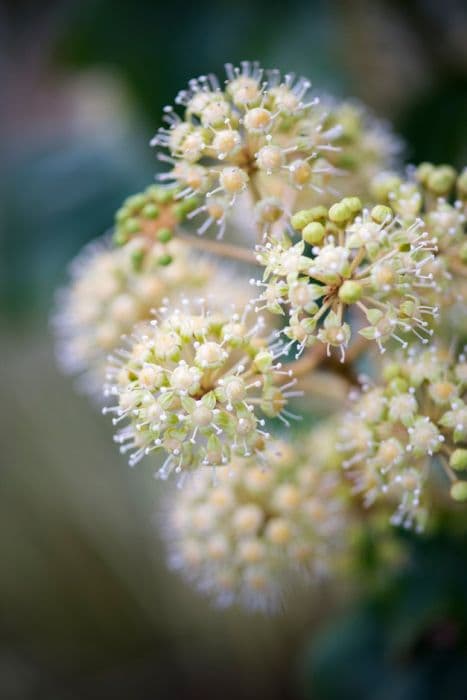English Ivy Hedera helix 'Green Ripple'

ABOUT
Hedera helix 'Green Ripple', commonly known as English ivy, is a vigorous climbing evergreen plant that is well known for its ornamental appeal. It is characterized by its beautiful, glossy leaves that are deeply lobed with a pronounced rippled or wavy texture, adding a dimensional aspect to its appearance. The leaves of 'Green Ripple' exhibit dark green hues with lighter green to yellow or white veining, creating a striking contrast that can catch the eye. The leaves are alternate and heart-shaped at the base, typically with five lobes, although the number of lobes can vary. They are leathery to the touch and have a slightly puckered surface due to the rippled effect. Each leaf is well-defined, with a prominent central vein from which secondary veins branch out, giving the leaf a somewhat palmate appearance. 'Green Ripple' produces small flowers, but they are not its most distinctive feature as they are often inconspicuous against the lush foliage. The plant has a trailing and climbing habit, with stems that can attach to surfaces via small rootlets that grow along them. This English ivy variety is popular for its aesthetic use in gardens, as groundcover, or in hanging baskets where its trailing vines can elegantly cascade down. Its unique leaf texture and coloration make it a favorite among gardeners looking to add a touch of sophistication to their plant collection.
About this plant
 Names
NamesFamily
Araliaceae.
Synonyms
English Ivy, European Ivy, Common Ivy, Ivy.
Common names
Hedera helix 'Green Ripple'.
 Toxicity
ToxicityTo humans
English ivy contains compounds such as saponins and polyacetylene compounds, which are toxic to humans. If ingested, the plant can cause symptoms including abdominal pain, vomiting, and diarrhea. In severe cases, it can lead to more serious reactions like inflammation of the skin or mucous membranes. Handling the plant might also cause dermatitis in sensitive individuals. It is essential to keep English ivy out of reach of children to prevent accidental ingestion.
To pets
English ivy is also toxic to pets, such as dogs and cats, due to the presence of saponins among other substances. If a pet ingests English ivy, they may exhibit signs of toxicity including vomiting, abdominal pain, hypersalivation, and diarrhea. In severe cases, ingestion can lead to more significant issues such as difficulty in breathing, coma, or rarely, death. As a result, it's imperative to prevent pets from accessing plants or plant parts.
 Characteristics
CharacteristicsLife cycle
Perennials
Foliage type
Evergreen
Color of leaves
Variegated
Height
6-8 feet (1.8-2.4 meters)
Spread
1-3 feet (0.3-0.9 meters)
Plant type
Climber
Hardiness zones
5-11
Native area
Europe
Benefits
 General Benefits
General Benefits- Easy to Grow: Thrives in a variety of conditions and can be grown both indoors and outdoors.
- Aesthetic Appeal: Adds greenery with its variegated leaves, enhancing the visual appeal of any space.
- Versatile Plant: Can be used as a ground cover, climbing vine, or as a potted plant.
- Low Maintenance: Requires minimal care once established, making it ideal for busy or novice gardeners.
- Fast Growing: Quickly covers empty spaces in gardens or walls, providing a lush look in a short period.
- Erosion Control: As a ground cover, it can help prevent soil erosion in landscapes.
 Medical Properties
Medical Properties- Hedera helix, commonly known as English ivy, has been used in folk medicine for its expectorant properties, which may help in relieving coughs and congestion.
- It contains saponins that are thought to have mucus-clearing properties, aiding in the relief of bronchitis symptoms.
- Topical preparations made from the plant have been applied to the skin for their anti-inflammatory effects, potentially offering relief from minor pain and swelling.
- The plant has also been used traditionally to treat skin conditions due to its potential antimicrobial properties.
 Air-purifying Qualities
Air-purifying QualitiesThis plant is not specifically known for air purifying qualities.
 Other Uses
Other Uses- Hedera helix 'Green Ripple', commonly known as English ivy, can be used in topiary art, where the plant is trained to grow over a frame, forming various shapes and designs.
- English ivy can be used as a natural dye for fabrics, yielding a range of colors from yellow to soft green depending on the mordant used.
- English ivy is often used in festive decorations, particularly during winter holidays, as it can be woven into wreaths or included in table centerpieces.
- The vines of English ivy can be used in crafts for making crowns or headpieces for garden-themed parties or events.
- It can be used to create a living curtain or privacy screen on balconies or patios when grown along trellises or other vertical supports.
- English ivy can be grown as ground cover in areas where grass struggles to grow, such as under dense tree canopies.
- This plant can also be used to create a natural backdrop for aquariums, by framing the outside back glass panel with its leaves, provided it is kept outside the water.
- English ivy is suitable for creating green roof gardens, helping to insulate buildings and provide habitats for urban wildlife.
- Small clippings of English ivy can be used as natural confetti for outdoor celebrations, as they are biodegradable and less harmful to the environment than plastic alternatives.
- Photographers may use English ivy to add a touch of natural greenery to staged photoshoots or as a backdrop for portrait photography.
Interesting Facts
 Feng Shui
Feng ShuiThe English Ivy, which Hedera helix 'Green Ripple' is a variety of, can be used in Feng Shui to introduce wood element energy and to promote better air quality, which is believed to enhance the overall chi in a space. It can be placed in areas that require growth and upward movement, symbolizing career advancement or personal development. However, it should be used with care as it can also bring in too much yin energy if overused or placed in a bedroom, which might lead to lethargy.
 Zodiac Sign Compitability
Zodiac Sign CompitabilityThe English Ivy is not used in astrology practice.
 Plant Symbolism
Plant Symbolism- Fidelity: English Ivy, as a clinging plant, symbolizes attachment and undying affection, representing faithfulness in relationships.
- Friendship: Its ability to interweave in growth mirrors the interconnectedness and support in friendships.
- Perseverance and Determination: The plant's vigorous growth habit reflects an ability to overcome challenging conditions and persist where others might not.
- Protection: Traditionally used to ward off evil spirits, English Ivy symbolized protection and safekeeping.
- Eternal Life: Evergreen properties of English Ivy make it a symbol of immortality and eternal life.
- Memory and Remembrance: The plant's resilience and lasting nature associate it with memories that endure over time.
 Water
WaterEnglish Ivy requires consistent moisture, so water it when the top inch of soil feels dry to the touch, which is typically once every 7 to 10 days. It's essential to avoid overwatering, as the plant is prone to root rot. Water thoroughly until excess water drains out of the pot's bottom, using roughly 1 gallon for a large pot during each watering. Adjust water frequency based on the season, watering less during winter months when the plant is dormant.
 Light
LightEnglish Ivy thrives in bright, indirect sunlight but can also adapt to low-light conditions. The ideal spot would be near a window that gets sun for some part of the day, but not where the plant will be exposed to direct sunlight, which can scorch its leaves. It can also do well with artificial light, making it suitable for offices or rooms without much natural light.
 Temperature
TemperatureEnglish Ivy prefers temperatures between 50°F and 70°F, but can survive in temperatures as low as 10°F for short periods. Avoid placing your English Ivy in areas with temperature fluctuations, such as near air conditioning or heating vents. The plant can also tolerate up to 90°F but will appreciate increased humidity in higher temperatures.
 Pruning
PruningPruning English Ivy helps maintain its shape and encourage fuller growth. Prune any overgrown or dead parts back to healthy growth in early spring or late winter for best results. It can be pruned as often as required to maintain the desired size and shape, using clean and sharp shears to make precise cuts.
 Cleaning
CleaningAs needed
 Soil
SoilEnglish Ivy 'Green Ripple' thrives in a well-draining, loamy soil mix with a pH of 6.0 to 7.5. A mix of two parts peat, one part perlite, and one part organic compost is ideal, ensuring adequate drainage and nutrient retention.
 Repotting
RepottingEnglish Ivy 'Green Ripple' should be repotted every two years or when its roots outgrow the current pot, typically in the spring.
 Humidity & Misting
Humidity & MistingEnglish Ivy 'Green Ripple' prefers high humidity levels, ideally between 40% to 70%. A humidifier or regular misting can help maintain these conditions.
 Suitable locations
Suitable locationsIndoor
Place in bright, indirect light and maintain consistent moisture.
Outdoor
Part shade to full shade and protect from harsh midday sun.
Hardiness zone
5-11 USDA
 Life cycle
Life cycleCommonly known as English Ivy 'Green Ripple', the life of this plant begins with seed germination, typically in spring, under favorable moisture and light conditions. The seedlings then develop into juvenile ivy plants, characterized by their lobed, trailing leaves, and have an affinity for climbing or sprawling across the ground. As the plant matures, it enters a vigorous vegetative growth phase where it establishes a dense, evergreen coverage with its distinctive, rippled leaves. English Ivy 'Green Ripple' may eventually produce clusters of small, inconspicuous flowers in late summer to fall, which, if pollinated, can develop into blue-black berries. The berries serve as a food source for birds and contribute to the plant's dispersal as the birds spread the seeds. Over time, the plant may transition into its adult phase with less-lobed leaves if it begins vertical growth up structures or trees, and these adult plants are the ones primarily responsible for flowering and fruiting.
 Propogation
PropogationPropogation time
Spring-Early Summer
The most popular method for propagating English Ivy, specifically the Hedera helix 'Green Ripple', is through stem cuttings. This can be done almost any time during the year, but the best time is during spring or early summer when the plant is actively growing. To propagate via stem cuttings, take a 4- to 6-inch (10-15 cm) cutting from a healthy stem that has several leaves. Remove the leaves from the lower half of the cutting and dip the cut end into rooting hormone. Plant the cutting in a pot filled with moist potting mix and cover it with a plastic bag to create a greenhouse effect. Keep the pot in a warm area with indirect light and maintain the soil moisture. Roots typically develop in two to four weeks, after which the plastic can be removed and the young plant can be gradually acclimatized to less humid conditions before eventually repotting.









